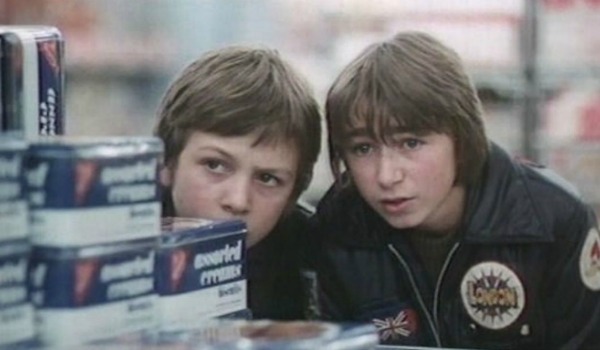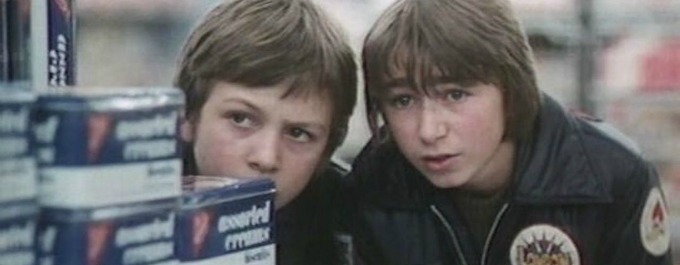If you stopped someone on the street and asked them to name the film in which a young boy encounters a stranded friendly alien, defends it from threatening adults and helps it return to its home world, chances are the answer they would give you is E.T. THE EXTRA-TERRESTRIAL. It is very unlikely, except perhaps if you are conducting your survey on the streets of Cambridge over the next few weeks, that the answer you would receive is THE GLITTERBALL. But five years prior to E.T., the British Children’s Film Foundation released a film that almost serves as a plot prototype of Spielberg’s sentimental classic.
The trail does not stop there though. The plot of THE GLITTERBALL was not unique in the Children’s Film Foundation output. It was in fact preceded by a number of other CFF films that pitted the innocent child against villainous adults, with the life of a lonely alien at stake. In SUPERSONIC SAUCER a group of school children protect an alien, Venus, from the nefarious intentions of a criminal gang. In THE MONSTER OF HIGHGATE PONDS another group of children befriends the eponymous monster. The same plot structure even underlies the popular CFF serial DANNY THE DRAGON.
Founded in 1951 in response to concerns about the quality of the films post-war children were beginning to enthusiastically consume, the Children’s Film Foundation made children’s films from the 1950s to the 1980s that had an emphasis on ‘clean, healthy, intelligent adventure’. If you are thinking that sounds like the Famous Five on screen, you would not be wrong. The first adaptation of Enid Blyton’s work was in fact made by the CFF. Given the gender politics of Blyton’s work, it might also not be surprising to note that the only female character to appear in THE GLITTERBALL (other than a checkout girl) is a worthy housewife (Marjorie Yates) who tolerates the regular house moves of a forces family with good humour and industry. Her husband, Sergeant Fielding (Barry Jackson), heads up a RAF radar team. The key action, however, revolves around their son, Max (Ben Buxton) who discovers a small alien visitor with a big appetite.
THE GLITTERBALL is oddly reminiscent of Judith Kerr’s children’s novel THE TIGER WHO CAME TO TEA (1968), not just for its reinforcement of the patriarchal family – the tiger drinks all Daddy’s beer, the mother has nothing left to make for Daddy’s tea – but also for its repetition of the unexpected visitor with a voracious hunger. In THE GLITTERBALL this is not a tiger, but a spherical alien (in fact, a silver-painted ping pong ball) who has crash landed in England and needs astonishing quantities of custard, as well as pretty much any other food stuff going, from chocolate to dog biscuits, in order to summon enough energy to communicate with Max and his new firm friend Pete (Keith Jayne). But whilst THE TIGER WHO CAME TO TEA contains not a hint of irony, THE GLITTERBALL seems to know that the world it is evoking is a fantastic one – both the story of the visiting alien and that of the innocent free-roaming boyhood action adventure.
“It may appeal more to the generation that grew up in the late 70s and early 80s who remember swiss rolls and lumpy custard with nostalgia … “
This self-deprecating humour is there from the very first. The film opens with the RAF radar team picking up a strange signal that suddenly disappears. ‘What was that then, Sarge,’ asks one of the radar operators, ‘Martians?’; ‘Yeah,’ is Fielding’s deadpan response ‘We’ve been invaded’. Later, when Max and Pete lose the visiting alien to the comedy baddy, George ‘Filthy’ Potter, Pete insists that they must retrieve it since ‘if he’s nasty to it he could start an interplanetary war’; ‘Never thought of that,’ replies Max. THE GLITTERBALL is a brilliant parody of the alien invasion film in which the ineffectual RAF spend the entire film chasing the alien around the countryside. It is also deliberately non-rational science fiction – there is no attempt to explain where the alien puts all the food it consumes, or even how it consumes it. When Max insists that the alien is alive, Pete asks how can it be, ‘Where is its mouth?’. But the film is also a comic fantasy about boyhood in which children make instant friendships, have brilliant tree houses, get to hitch a lift on an ice-cream van and, Dukes of Hazard-style, disembark by jumping out through its serving window. And they get to do all that, as well as knock over towers of cereal in supermarkets (who still doesn’t want to do that?) without repercussions and without interference from the adult world (apart from the essential baddy).
It remains to be seen what an audience of contemporary children will make of THE GLITTERBALL. It may appeal more to the generation that grew up in the late 70s and early 80s who remember swiss rolls and lumpy custard with nostalgia. Its pre-CGI special effects and chase scenes featuring bicycles and ice-cream vans will no doubt appear clunky and slow compared to today’s slick science fictional cinematic output. But there is a sense in which the film already knows it is out of date – and that deliberate humour makes it both highly entertaining and enduringly loveable.
Sarah Dillon
The Glitterball screens on 5th Sep at 18.00 at the Cambridge Film Festival, in a double bill with THE BOY WHO TURNED YELLOW.


